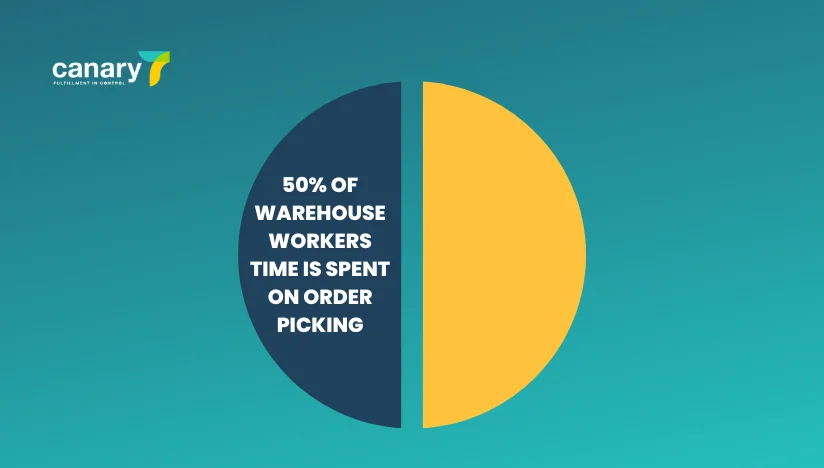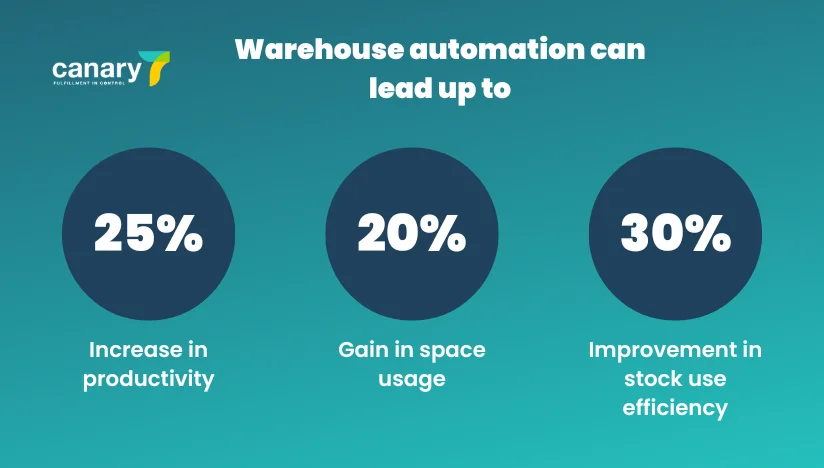Warehouse Management Systems Lead the Way
72% of respondents identify warehouse management systems (WMS) as the premier warehouse automation software (Supply Chain Management Review). Warehouse management systems (WMS) go beyond warehouse management, offering functionalities like inventory management, order management, and labor management. A robust WMS can become the cornerstone of your warehouse automation strategy.
Warehouse Automation Statistics for Efficiency
Order Picking and Time Management
Order picking consumes at least 50% of warehouse workers’ time (Sciendo). Even with partial automation, order picking remains a time-consuming process. This statistic emphasizes the need for comprehensive automation solutions to streamline picking tasks and boost overall efficiency.
Accuracy Improvements with Automation
Warehouse automation systems can increase picking accuracy to 99.99% (MHI). Automation not only speeds up picking but also minimizes errors. Warehouse automation systems like WMS can ensure smooth and accurate fulfillment by automating specific picking tasks.
Cost Efficiency and ROI
Warehouse management systems and pick-to-light systems cost between $500,000 and $2 million, with a payback period of 0.5 to two years (Westernacher). While the upfront cost might seem substantial, the rapid return on investment makes it a compelling proposition for businesses seeking cost efficiency.
The Impact of Robotics on Logistics
Robotics could reduce logistics costs by up to 40% and increase productivity by 25% to 70% by 2025 (Roland Berger via Sales Layer). Robotics, a form of warehouse automation, holds immense potential for the future. It can free up human workers for more complex tasks while enhancing productivity and reducing costs.
Workflow Automation Adoption
31% of businesses have fully automated their workflows at least once (SelectHub). This statistic highlights the growing adoption of warehouse automation solutions. Businesses are increasingly recognizing the advantages of automation in overcoming operational challenges and achieving optimal efficiency.
Warehouse Automation Statistics for Labour Management
1. High Labour Costs
Labour accounts for at least 50% to 70% of a company’s warehousing budget (G2). High labor costs highlight the financial benefits of warehouse automation in reducing dependency on manual labor.
2. Safety Improvements
Warehouses have a high injury rate, with roughly 1 in 20 workers sustaining injuries (US Bureau of Labor Statistics). Warehouse automation can mitigate this risk by automating hazardous tasks and improving workplace safety.
3. Cost Savings
A typical warehouse with 100 employees can incur labor expenses exceeding $3.5 million annually (Westnacher). Warehouse automation can be a cost-effective alternative to a large workforce, offering more reliable and efficient operations.
4. Labour Shortages
73% of warehouse operators struggle to attract enough qualified labor (Instawork). The ongoing labor shortage in logistics makes automation even more critical. By automating tasks, businesses can become less dependent on manual labor and mitigate the impact of staffing challenges.
5. Training and Retention
54% of organizations plan to invest in supply chain and technical training to retain their workforce (Logistics Management). While automation is taking center stage, skilled workers remain crucial. Businesses can leverage automation to create a safer and more satisfying work environment, boosting employee retention.
Warehouse Automation Implementation Statistics
1. Investment in Automation Systems
66% of companies expect to invest in conveyor and sortation systems in the next three years (Modern Materials Handling). The widespread adoption of these systems indicates a shift towards more automated fulfillment processes.
2. Global Adoption of Automation Technologies
Over 620,000 shipments of various warehouse automation technologies are expected worldwide by the end of 2024 (Omdia). This substantial number reflects the global embrace of warehouse automation. As more businesses recognize its advantages, the demand for automation solutions is likely to surge further.
3. Importance of Innovation
96% of industry leaders view innovation as crucial for growth (Deloitte). Embracing innovative technologies like warehouse automation is essential for staying competitive.
Warehouse Automation Statistics: Future Outlook
Growth of Robotic Warehouses
Predictions suggest there will be around 50,000 robotic warehouses by 2025, housing over 4 million robot installations (European Business Review). The rise of robotic automation signifies a significant transformation within the warehousing industry. Robots can handle tedious tasks with precision, minimizing errors and ensuring peak efficiency.
Market Expansion
The global warehouse automation market is expected to surpass $54.53 billion by 2030, growing at a compound annual growth rate (CAGR) of 16.20% during the forecast period (Mordor Intelligence, Research and Markets). This phenomenal projected growth reflects the immense potential of warehouse automation. As technology advances and solutions become more accessible, widespread adoption is likely.
Key Takeaways
Warehouse automation presents a future-proof approach for businesses to stay ahead of the curve and cater to the evolving needs of modern consumers. Statistics paint a clear picture: automation offers a multitude of benefits, including enhanced efficiency, improved labor management, and cost-effective operations. As the industry continues to witness rapid growth and innovation, businesses that embrace warehouse automation are well-positioned to thrive in the years to come.
Embracing Automation: The Road Ahead
Over the next three years, an estimated 60% of companies plan to invest in conveyor systems and sortation systems (Parcel Industry). This statistic signifies the widespread adoption of specific automation technologies within warehouses. Businesses are actively seeking solutions to enhance efficiency and streamline fulfillment processes.
By the end of 2022, global shipments of various warehouse automation technologies are expected to reach approximately 620,000 (Omdia). This substantial number reflects the global embrace of warehouse automation. As more businesses recognize its advantages, the demand for automation solutions is likely to surge further.
A Glimpse into the Future of Warehouse Automation
Predictions suggest there will be around 50,000 robotic warehouses by 2025, housing over 4 million robot installations (Kardex-Remstar). The rise of robotic automation signifies a significant transformation within the warehousing industry. Robots can handle tedious tasks with precision, minimizing errors and ensuring peak efficiency.
The global warehouse automation market is expected to surpass $54.53 billion by 2030, growing at a compound annual growth rate (CAGR) of 16.20% during the forecast period (Mordor Intelligence, Research and Markets). This phenomenal projected growth reflects the immense potential of warehouse automation. As technology advances and solutions become more accessible, widespread adoption is likely.


